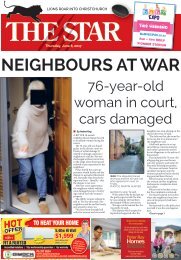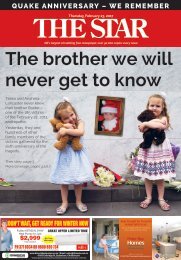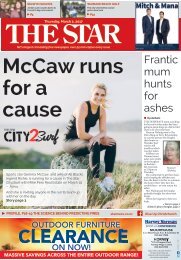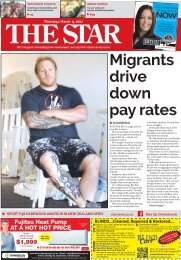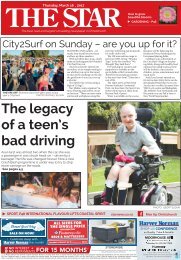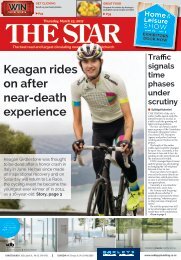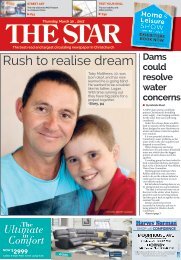Review of the Tsunami Evacuation 2017
Create successful ePaper yourself
Turn your PDF publications into a flip-book with our unique Google optimized e-Paper software.
<strong>the</strong>ir local areas. They want to be involved in <strong>the</strong> collation <strong>of</strong> this information to ensure that<br />
<strong>the</strong> presentation <strong>of</strong> <strong>the</strong> information meets <strong>the</strong> needs <strong>of</strong> <strong>the</strong>ir specific communities.<br />
7. Residents want information which includes evacuation maps (exactly how far do <strong>the</strong>y need to<br />
go?), evacuation routes (where do <strong>the</strong>y need to go and how best to get <strong>the</strong>re?), scientific<br />
information on <strong>the</strong> probability <strong>of</strong> a tsunami or inundation event specific to <strong>the</strong>ir area (how<br />
high will <strong>the</strong> waves be?) and information on <strong>the</strong> different types <strong>of</strong> tsunamis (how much time<br />
do <strong>the</strong>y have to evacuate?).<br />
8. Residents are looking to CDEM to coordinate <strong>the</strong> o<strong>the</strong>r agencies and residents to co-create <strong>the</strong><br />
information which will be disseminated to residents. Residents want to and should participate<br />
in <strong>the</strong> creation <strong>of</strong> community specific evacuation plans. This will require strategic planning,<br />
resources and commitment from all those involved.<br />
Background<br />
The tsunami evacuation on 14 November 2016 and related messaging from various agencies caused<br />
confusion not only amongst Christchurch residents but right across New Zealand. This statement is<br />
based on input from Christchurch residents and many comments posted on social media. The large<br />
scale evacuation (which covered almost <strong>the</strong> entire country) as directed by MCDEM was<br />
unprecedented.<br />
Different regions responded differently to <strong>the</strong> national warning messages issued by MCDEM. In some<br />
regions (i.e. Auckland), local authorities did not activate evacuations on <strong>the</strong> basis that it was<br />
unnecessary in <strong>the</strong>ir region. Their decisions were based on tsunami modeling, tidal gauges and visual<br />
assessments undertaken at a local level to determine <strong>the</strong> response required to <strong>the</strong> threat.<br />
In Christchurch, an evacuation was activated at 2:11am following <strong>the</strong> national warning message<br />
(issued by MCDEM) received at 2:01am which clarified that <strong>the</strong> tsunami threat also related to land<br />
(not just marine and beach areas) and following a telephone call from CDEM to Group at 2:05am<br />
where it was made clear to CDEM that <strong>the</strong> National Controller was directing an evacuation <strong>of</strong><br />
Christchurch coastal areas.<br />
As advised by MCDEM, “<strong>the</strong> 14 November event has now been described by scientists as <strong>the</strong> most<br />
complex earthquake in historical times worldwide, with 21 separate faults over 140kms rupturing in<br />
sequence. During <strong>the</strong> event tsunami waves severely damaged a property in Little Pigeon Bay,<br />
Canterbury. No-one was present in <strong>the</strong> house at <strong>the</strong> time. Given <strong>the</strong> degree <strong>of</strong> damage to <strong>the</strong> building,<br />
<strong>the</strong> depth and velocity <strong>of</strong> <strong>the</strong> water, and <strong>the</strong> movement <strong>of</strong> very large furniture inside <strong>the</strong> house, it is<br />
possible that if people were present, <strong>the</strong>re would have been causalities and potentially fatalities. It is<br />
essential that a precautionary approach be taken when lives are at risk. MCDEM’s message to<br />
evacuate was based on best scientific advice at <strong>the</strong> time”.<br />
Scope <strong>of</strong> <strong>Review</strong><br />
The report writer was selected on <strong>the</strong> basis that she has no involvement in civil defence or emergency<br />
matters.<br />
The terms <strong>of</strong> reference <strong>of</strong> <strong>the</strong> report was to seek clarification on why messaging was inconsistent<br />
between agencies and <strong>the</strong> media, how <strong>the</strong> evacuation decision-making process works, how evacuation<br />
<strong>of</strong> coastal communities can be better coordinated, what information communities require and how<br />
<strong>the</strong>y can access such information.<br />
The terms <strong>of</strong> reference envisaged <strong>the</strong> report writer corresponding with any internal Council staff<br />
required, as well as external people within <strong>the</strong> Christchurch region who could provide relevant<br />
5



